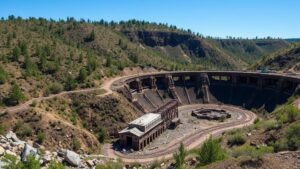Mining Innovations of the Han Dynasty: Early Rock Drilling Methods
Mining Innovations of the Han Dynasty: Early Rock Drilling Methods
The Han Dynasty, which lasted from 206 BC to 220 AD, marked a significant period of technological advancement in ancient China. Among its many contributions to civilization, innovations in mining and metallurgy played a crucial role in supporting the growing demand for resources such as iron, copper, and salt. In particular, early rock drilling methods utilized during this era laid the groundwork for later mining techniques that advanced industrial productivity. This article explores the innovative drilling methods developed during the Han Dynasty, highlighting their significance and real-world applications.
The Context of Mining in the Han Dynasty
The Han Dynasty is often celebrated for its vibrant economy and significant expansion of trade. The mining sector was instrumental in this growth, primarily due to the governments investment in resource extraction to support military, infrastructure, and agricultural needs. As such, advancements in mining technology were not only crucial for meeting the demands of the state but also catalyzed greater economic activities.
Early Rock Drilling Techniques
Rock drilling during the Han Dynasty was primarily achieved through the use of primitive tools and techniques that significantly evolved from earlier practices. dominant method employed was the use of hand-held drills, which consisted of wooden frames and iron drill bits. These tools utilized a rotational motion to penetrate rock, relying on human or animal power for operation.
- Trepanation Technique: This method involved a cylindrical drill, often referred to as a trepan, combined with abrasive materials to grind away at rock surfaces. It was particularly effective in creating holes for extracting minerals.
- Use of Bronze Drill Bits: Innovations in metallurgy led to the use of durable bronze drill bits, which could maintain a sharp edge longer than their stone counterparts. This allowed for greater efficiency in drilling operations.
Impact and Efficiency of Innovations
The innovations in rock drilling were not merely technological achievements; they also had a profound impact on mining operations. For example, the increased efficiency of bronze drill bits allowed miners to deepen shafts and tunnels significantly faster than before. Historical records indicate that the productivity of mining operations could increase by as much as 30% with the adoption of these new techniques.
Also, these advancements enabled the Han Dynasty to tap into previously inaccessible mineral deposits. ability to drill through hard rock opened new veins of resources, which in turn enriched the empire and facilitated trade. The demand for iron for weapons and tools saw widespread extraction efforts led by state-sponsored mining operations, which employed these improved drilling methods extensively.
Comparative Analysis with Other Civilizations
When examining the Han Dynasty’s drilling innovations, it is valuable to consider them in a comparative context with other contemporary civilizations. For example, the Roman Empire also made strides in mining during this period, utilizing large-scale hydraulic mining techniques.
But, Han innovations were characterized by a more refined approach to manual drilling techniques, which aligned with their labor-intensive methods. While the Romans relied on technological advancements such as water wheels and machinery for scale, Han miners focused on enhancing the efficacy of manual tools, making their approach distinct.
Real-World Applications of Mining Innovations
The technologies developed during the Han Dynasty have had lasting implications beyond their immediate historical context. Many of the methods and tools were foundational for future advancements in mining engineering. The evolution of drilling techniques paved the way for innovations seen in the medieval period and even the Industrial Revolution.
Lessons from the Han Innovations
Modern mining operations can derive several lessons from the early rock drilling methods of the Han Dynasty:
- Investment in Technology: State-sponsored research and development can lead to significant advancements in resource extraction methods.
- Efficiency through Innovation: Regular updates to tools and techniques can enhance productivity and open new operational frontiers.
To wrap up, the rock drilling innovations of the Han Dynasty represent a pivotal chapter in the history of mining technologies. By harnessing human ingenuity and developing more effective tools, they not only advanced resource extraction methods of their time but also laid the groundwork for future generations in the field. Understanding these developments can inform modern practices in mining and resource management, ultimately contributing to sustainable practices in a resource-dependent world.


